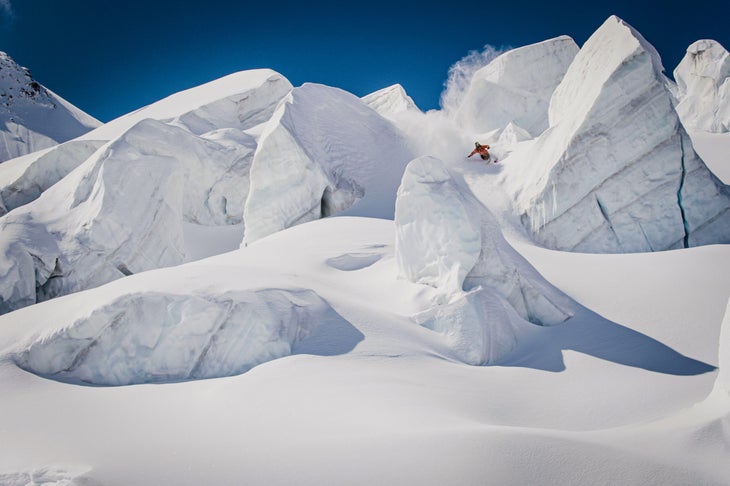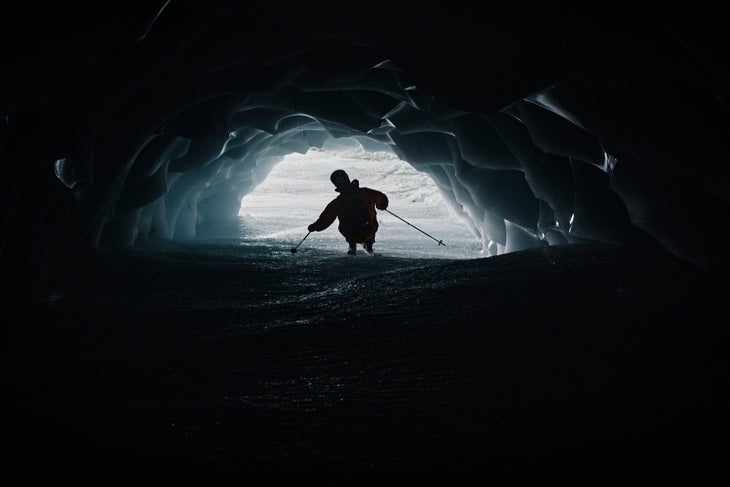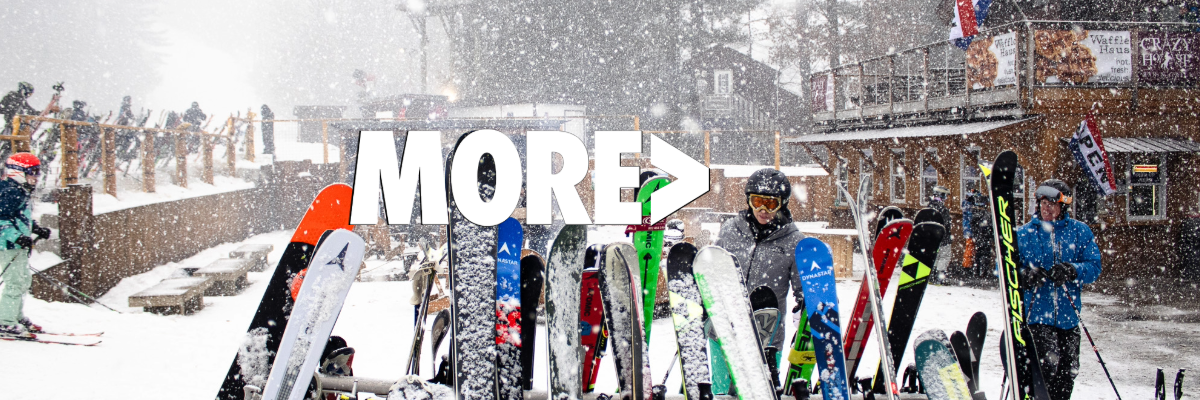Get full access to Outside Learn, our online education hub featuring in-depth fitness, nutrition, and adventure courses and more than 2,000 instructional videos when you sign up for Outside+
Sign up for Outside+ today.
Freeskiing phenom Markus Eder still can’t believe it. His 10-minute ski film, “The Ultimate Run,” actually won a Sports Emmy award for outstanding camera work.
It’s not often a ski film gets noticed by mainstream media, let alone nominated for a Sports Emmy award. So when “The Ultimate Run”, co-produced by Legs of Steel and Red Bull, received not just one, but two Sports Emmy nominations on April 12, it was a big deal. Still, as incredible and beautiful as this ski film is, Eder thought that the chances of actually walking away with an Emmy in hand were slim. The film was up against big productions like Netfllix’s “The Alpinist,” after all.
“To be honest, when we sat at the award ceremony in New York, I didn’t think we’d win,” Eder told SKI. “They [the National Academy of Television Arts & Sciences] just don’t have a clue of what it means to deal with the harsh mountain environment, snow conditions, crevasses, avalanches, and so on.”
But it seems you don’t have to be a skier to appreciate the stunning cinematography in “The Ultimate Run,” because on May 22, Eder and his crew officially had a Sports Emmy in hand.
The award is recognition from mainstream media that “The Ultimate Run” is more than just another ski edit that flaunts a professional skier’s talent on skis. It’s a testament to Eder’s creative vision as an athlete, as well as the wizards behind the cameras and in the editing rooms, including director Christoph Thoresen and Legs of Steel producer Daniel Schiessl.
SKI caught up with Eder and Schiessl after they had a few weeks to process their Emmy win to chat about everything that went into this project and what this award means to them.

The following interview has been edited for length and clarity.
SKI: Let’s start at the beginning. Markus, what inspired this project? How did you come up with the concept for “The Ultimate Run”?
Eder: My good friend Scott Gaffney from Matchstick Productions was definitely the guy to plant the seed in my head. I tried to film it with Scott in 2015, when the idea was still much simpler, but I ended up dislocating my shoulder on the first shoot.
After 2015 the project was on hold since there were many other things I wanted to check off my list first. But the idea that I could ride everything I wanted and have a production crew to support all of my ideas kept growing over the years. I’ve never had a segment where I was able to show all my skiing skills. Usually you’re always with a film crew involving other riders, so you take what you get and make the best of it.
After winning the Freeride World Tour in 2019, knowing that I’d have all the full credibility from sponsors, it was finally time. Rather than doing many different projects in one season, it was finally time to dedicate two entire seasons to these 10 “simple” minutes.
Related: Candide Thovex produced another edit we can’t stop watching
SKI: What was your favorite part about this project, the skiing or piecing together the lines and various ski segments between the glacier in Zermatt and the riding at your home resort of Klausberg, Italy?
Eder: It was all of it. Having the possibility to let loose completely on my creativity in riding, finding and building features especially. But also analyzing weather patterns and snow conditions is something I love, as well as giving my input in the filming aspect as well as editing.
SKI: The skiing in this film speaks for itself, so let’s focus on the camera and editing work, which is what won the film an Emmy. The visuals are stunning, but what makes the cinematography and camera work stand out from other sports films?
Schiessl: Markus had his vision of the run, and Christoph [director of photography] brought in 20 years of filmmaking experience and a passion for dynamic camera work. It’s teamwork and Markus as the athlete plays just as an important role as all the others.
Eder: We continually messed around with the shots while filming to understand how the individual shots would fit together the best, and which action and connection shots we still needed to really give the viewer the feeling of following me down one entire run. I wouldn’t have ever thought that you could put that much time into 10 minutes of video.
SKI: How many cameras and camera people were involved on the mountain?
Schiessl: In total “only” 11 filmers, that includes Markus’ POV camera. We weren’t a real production crew. Actually, our approach was exactly the opposite. On plenty of days it was just Markus, Christoph flying the drone and operating the remote controlled gimbal, and me skiing with the gimbal.
SKI: The shots and the setups are unreal in this film. Did you have to use special camera equipment to follow Markus into some of those crazy features, like the glacier cave and the castle?
Schiessl: Not too many. We tried to have a RED standard for all tripod and handheld shots. Drone shots were almost entirely done with a DJI Inspire 2, which was always single-man operated by Chirstoph. That’s crazy if you look at some of the shots, especially the one in the old mining town.
Our secret weapon was the gimbal camera setup that Christoph built just before we started filming. A Z-Cam, a fairly light but good camera, on a Ronin gimbal. I skied with the setup, while the zoom and gimbal were remotely controlled by Christoph.
SKI: What makes producing a ski film like “The Ultimate Run” particularly challenging?
Schiessl: Filming on snow is hard. The weather, the snow conditions, the danger of avalanches and other external factors. And if you add to that you are aiming for a consecutive looking run in similar light and snow conditions, most of it had to be first tracks… You could not make it much more complicated, but that was also what made it so tempting.
Eder: Covid and the strict lockdown in Italy didn’t help, but getting to the end was most challenging for me. We started to shoot the urban segments and everything in the valley in December when there’s actually snow down low. Then we moved to the resort in February until the end of winter, and then went on to Zermatt to shoot the glacier section as that was coming into conditions. So we shot from the bottom up. And until we got that very last (first) shot, there was no beginning to the film.

I was definitely pushing myself, too. My big worry was getting hurt throughout the process and letting down everyone who worked so hard. We simply wouldn’t have had a beginning. Also, the conditions weren’t always easy to deal with and that all messed with my mind quite a bit. Then finally, on July 2, 2021, we managed to film the drop-in shot on the glacier. The very last shot. Finally.
Schiessl: If I think back on the amount of days where we had wind-scoured snow and couldn’t really film, I am sometimes surprised that we stayed on track and didn’t lose sight of our goal. But we were also lucky. We had two winters in a row in Markus’s home ski resort with a snow base that was unusually high and stable. Without that, it would have made it a lot harder.
SKI: Did you know, after you had the footage in the can, that you had made something special?
Eder: I actually developed quite the weird relationship with this project. After we finished with the filming and especially with the editing, I didn’t feel any excitement anymore with this piece whatsoever. I could only tell theoretically that we made something special. I’ve gone so deep down the rabbit hole with it.
I knew the idea I initially brought to Legs of Steel was special. LOS and Christoph then brought it to another level. So I knew it had become much better than I initially thought. But still, from the release until today, I can’t watch it. I’ve seen it 500 times too often.
SKI: How do you feel now, with the Emmy in hand?
Schiessl: We didn’t even plan on trying to get nominated for a Sports Emmy. During post production our sound engineer made us aware of it and said we’d be stupid if we didn’t at least try. So this Emmy is [a symbol of] teamwork. I believe the triangle of Markus as the athlete, Christoph as the director, and us as the production crew made it happen together with all the other filmers and the rest of the crew involved.
Eder: It was satisfying for sure to take home the Emmy. It’s actually quite the credit for what we did, if I think about it now. But I also need to add, if I seek any kind of recognition, it’s the core freeski scene that I’d want it from. Those are the people who dedicate their life and health to this sport and give soul, meaning and purpose to what we do. The real freeski community knows the difficulty of the tricks and also understands what creating a movie like this means. They’re the most important to me.
Go behind the scenes of “The Ultimate Run” in this 17-minute video that’s almost more mind-bowing than the final film itself.
